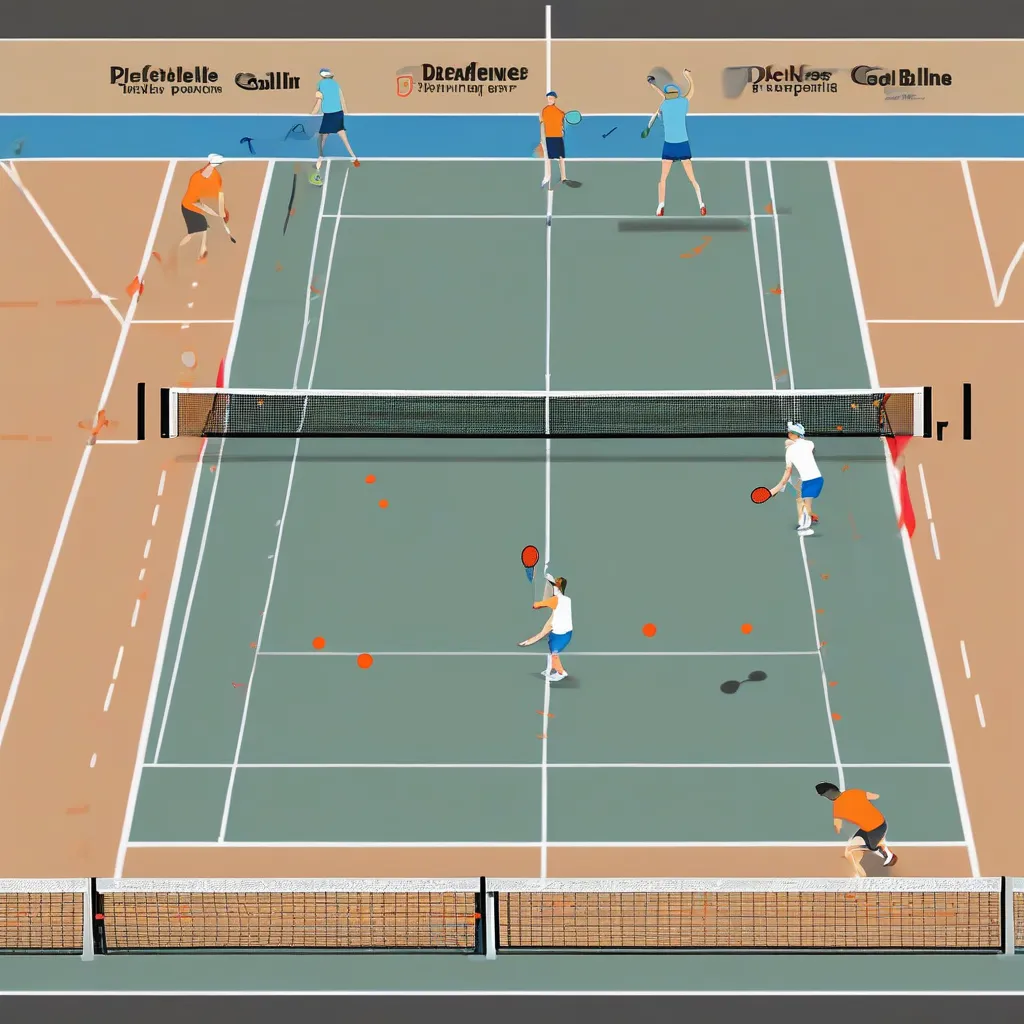Imagine this: You’re on the pickleball court, the sun is shining, and your opponent unleashes a powerful smash. Do you brace for impact or do you deftly return the shot? The answer lies in understanding basic defensive strategies. These strategies aren’t just about reacting; they’re about anticipating, positioning, and controlling the flow of the game. In this guide, we’ll explore the core principles of pickleball defense, equipping you to confidently handle any attack thrown your way.
The Foundation of Pickleball Defense: Positioning and Movement
The cornerstone of effective pickleball defense is your court positioning. Ideally, you and your partner should be positioned near the non-volley zone line (also known as the kitchen line), ready to react to any incoming shot. This central position allows you to cover a wider area of the court and return volleys efficiently.
Footwork Fundamentals for Defensive Success
Quick, agile footwork is paramount in pickleball defense. Being able to move laterally and forward and backward smoothly will allow you to reach those tricky shots. Practice shuffling sideways to cover the court quickly and efficiently. Short, controlled steps are key. Remember, “Proper footwork prevents foot faults and allows for more control over shot placement,” says renowned pickleball coach, Sarah Ansboury, author of “Pickleball Strategy: From Beginner to Pro”. This sentiment resonates with the core principles of defensive positioning. For more details on improving your footwork, check out our article on basic pickleball footwork techniques.
The Ready Position: Your Defensive Stance
Maintain a balanced, athletic stance with your weight slightly forward and your knees bent. Keep your paddle up and in front of you, ready to react. This “ready position” is your default defensive posture. “Think of your body like a coiled spring,” explains pickleball champion, Mark Renneson, “Ready to react and explode towards the ball”. This analogy captures the essence of the ready position, emphasizing the importance of preparedness and agility.
Key Defensive Strokes: Blocking and Resetting
While offensive strokes like serves and smashes are essential, a strong defense relies on blocking and resetting.
The Art of the Block: Neutralizing Power
Blocking is your primary weapon against powerful shots. The goal isn’t to return with force but to neutralize the attack and create a neutral rally. Keep your paddle face slightly open, using a soft, controlled motion to deflect the ball upward. This lift will create a higher arc, giving you more time to recover and regain control of the point. “Blocking is about absorbing energy, not generating it,” notes pickleball instructor, Lucy Kovalova.
Resetting the Rally: Creating Opportunities
Often, the best defense is a good reset. If you find yourself pushed back from the kitchen line, a deep, high return to your opponent’s backhand corner can give you time to recover and reposition yourself closer to the non-volley zone. This is a strategic retreat, not a sign of weakness. You’re aiming to regain control of the rally and dictate the next shot.
 Pickleball Defensive Positioning
Pickleball Defensive Positioning
Advanced Defensive Tactics: Anticipating and Communicating
As you progress in pickleball, you’ll learn to anticipate your opponent’s shots and communicate effectively with your partner.
Reading Your Opponent: Predicting Their Next Move
Observe your opponent’s paddle angle, body language, and previous shots. These cues can provide valuable insights into their intentions. “Pickleball is like a chess match,” says former pickleball pro, Simone Jardim. “Anticipating your opponent’s moves is just as important as your own strategy.”
Communication is Key: Working as a Team
Constant communication with your partner is vital for a solid defense. Call out shots, cover each other’s weaknesses, and strategize together. Clear communication minimizes confusion and maximizes your defensive effectiveness. For more insight into effective serving strategies, check out our article on drills to enhance pickleball serving strategy.
Dinking: A Defensive Weapon
Dinking, a soft shot that just clears the net and lands in the non-volley zone, can be a surprisingly effective defensive tool. By keeping the ball low and forcing your opponents to hit upward, you can disrupt their offensive rhythm and create opportunities for yourself. Mastering the dink requires finesse and control, turning what seems like a passive shot into a strategic advantage. For players starting their pickleball journey, understanding basic pickleball strokes is crucial. Explore our article on basic pickleball strokes for new players to enhance your game.
Turning Defense into Offense: The Transition Game
A strong defense doesn’t just prevent points; it sets the stage for offensive opportunities. By neutralizing powerful shots and creating resets, you can transition from a defensive posture to an offensive one. Be ready to pounce on weak returns and capitalize on any openings.
Conclusion
Mastering basic defensive strategies is the key to becoming a well-rounded pickleball player. From footwork and positioning to blocking, resetting, and anticipating your opponent’s moves, these skills form the foundation of a solid defense. Remember, effective defense isn’t passive; it’s an active process that requires focus, agility, and strategic thinking. Embrace the challenge, practice diligently, and watch your pickleball game reach new heights. Now, we’d love to hear from you. What defensive strategies have you found most effective in your pickleball games? Share your tips and experiences in the comments below! If you’re looking to refine your offensive game, don’t miss our guide on basic pickleball offensive strategies. How to position yourself on the pickleball court can provide invaluable insights to enhance both your offensive and defensive strategies.
- Baker, Joe (Author)
- English (Publication Language)
- Bond, Payton (Author)
- English (Publication Language)
- Anderson, Brian (Author)
- English (Publication Language)
- Palcic, Lisa (Author)
- English (Publication Language)
- Foster, Blake (Author)
- English (Publication Language)
- Carnot, Prem (Author)
- English (Publication Language)
- Hall, Dennis (Author)
- English (Publication Language)
- Callahan, John (Author)
- English (Publication Language)
- Publishing, Fitness Research (Author)
- English (Publication Language)
- Arthur, S. M. (Author)
- English (Publication Language)









